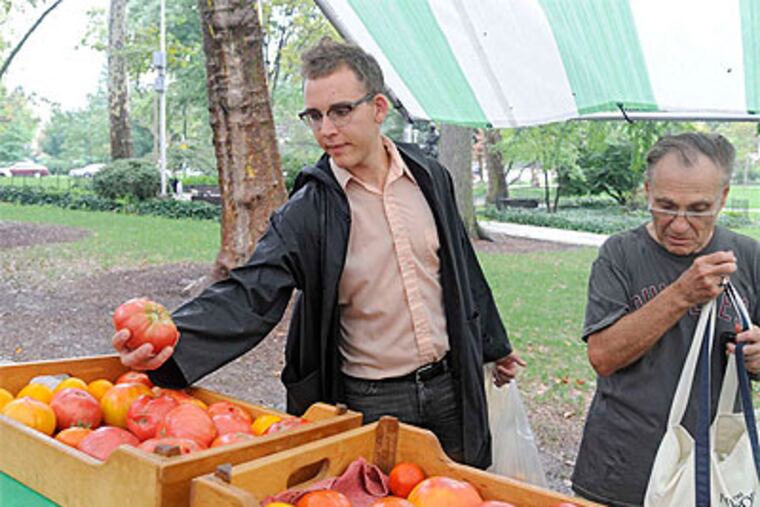Initiatives help get fresh food to Philadelphia's poorer areas
Far too little of Center City's success has translated into progress for Philadelphia's low-income neighborhoods. But one surprising exception has been the growing availability of fresh, locally grown foods in communities far from the foodie redoubt of downtown.

Far too little of Center City's success has translated into progress for Philadelphia's low-income neighborhoods. But one surprising exception has been the growing availability of fresh, locally grown foods in communities far from the foodie redoubt of downtown.
In 1992, three years before Steven Starr opened the first Continental and informally kicked off Philadelphia's (second) restaurant renaissance, the city had no more than three or four farmers markets. Twenty years later, one organization - the Food Trust - operates 30 markets on its own. And most of those, Food Trust executive director Yael Lehmann said, are in low- or mixed-income neighborhoods.
There's perhaps not a completely straight line to be drawn between the likes of Marc Vetri and a growing abundance of fresh and local food in the city's lower-income neighborhoods, but the relationship is stronger than you might think.
"Folks who are passionate about food tend to feel strongly that everyone should have access to fabulous food," Lehmann said.
Vetri, for instance, is trying to reinvent the school lunch, not just by replacing premeasured scoops of pasty potatoes with chickpea-and-cucumber salad, but also by setting the table family-style. He calls it "Eatiquette," and the idea is that "kids don't just eat lunch, they dine."
Or consider Fair Food, the farm-to-table nonprofit founded by White Dog restaurateur Judy Wicks, which helps supply 25 Philadelphia public schools with locally grown fruits and vegetables, and doubles the buying power of food-stamp users when they shop at Fair Food farm stands.
At first blush, it can be tempting to dismiss these and similar sorts of effort as empty, elitist do-gooderism, seasoned with a pinch or two of condescension. Philadelphia's low-income neighborhoods would seem, after all, to have bigger problems than too little kale.
But that's a glib instinct that overlooks the fact that fresh, locally grown food - food that actually tastes good and is healthy - may just be the answer to Philadelphia's obesity epidemic.
Indeed, the City of Philadelphia is in the midst of perhaps the nation's largest fresh-food availability experiment. The cornerstone of the effort is a healthy corner-stores initiative that seeks to persuade mom-and-pop outfits to stock a little less highly processed junk food and more fresh fruits, vegetables, and lean proteins.
The pitch isn't easy. Bodega owners operate on thin margins, and they must eat the cost of any wasted food. Bananas may spoil quickly, but a Slim Jim is forever.
Even so, the city, in cooperation with the Food Trust, has had some real success with this initiative. More than 600 stores participate in the program, out of about 1,500 citywide. Some participate more than others, of course, but there is no doubt more fresh food is available at corner stores in the city today than there was just a few years ago.
"We're still in the beginnings of that work. Our hope is that five years from now, you'll be able to see gorgeous produce in every corner store. We're hoping it becomes the norm," Lehmann said.
But does access to healthier food actually translate to better eating habits and lower obesity rates? There the data are unclear. Nationally, no studies have conclusively shown that an abundance of produce leads to healthier residents. Philadelphia is in the midst of such a study, and its findings will be examined closely nationwide.
Already, though, there are some encouraging signs that something is working in Philadelphia.
City researchers released a study last month documenting a 5 percent decline in obesity rates among Philadelphia schoolchildren between 2006 and 2010. The study didn't try to discern why the obesity rates fell, and its authors have cautioned against jumping to conclusions.
Still, they are pleased. "We're encouraged that progress is possible on this issue," said Giridhar Mallya, director of policy and planning for the city Health Department, "but still humbled by the fact that 20 percent of kids in Philadelphia are still obese."
Particularly notable was the fact that the decline in obesity was even more pronounced among Latino girls and African American boys.
"That tells me that we're doing something that's having an impact way beyond Rittenhouse Square," Lehmann said.